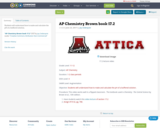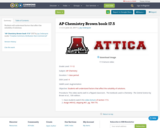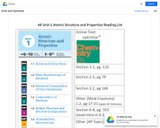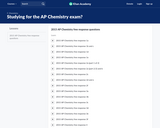
Students will understand the importance of the common ion effect when looking for the pH of weak acids.
- Subject:
- Applied Science
- Material Type:
- Lecture
- Lesson Plan
- Date Added:
- 06/23/2017

Students will understand the importance of the common ion effect when looking for the pH of weak acids.

Students will understand how to make and calculate the pH of a buffered solution.

Students will understand how to calculate the pH during different types of acid-base titrations, including guidelines from determining which indicator to use.

Students will understand how to use the solubility equilibrium constant to calculate the solubility of compounds

Students will understand factors that affect the solubility of solutions.

Students will understand how to calculate the equilibrium quotient to determine the direction of solubility and solid formation.

This activity is an instructional activity that can be used in AP Chemistry with Topic 1.1. The activity has students arrange samples with different units in three different ways to show that they know how to perform different mole problem calculations.

This module has two parts:1- Introduction to the concept of a "mole" and Avogadro's number.2- Application of the Mole (Avogadro's number) as a conversion factor relating mass in grams to number of atoms or molecules (formula unit for ionic compounds)

*This is not my own resource,* but one I found on the AP Chemistry Teachers Facebook page. This book is now one of the pre-approved texts for AP Chemistry. This google folder contains a doc for each unit with the unit topics outlines and aligned with textbooks sections.

Studying for the AP Chemistry exam? Watch these videos to help you prepare!

Students learn how common pop culture references (Harry Potter books) can relate to chemistry. While making and demonstrating their own low-intensity sparklers (muggle-versions of magic wands), students learn and come to appreciate the chemistry involved (reaction rates, Gibb's free energy, process chemistry and metallurgy). The fun part is that all wands are personalized and depend on how well students conduct the lab. Students end the activity with a class duel a face-off between wands of two different chemical compositions. This lab serves as a fun, engaging review for stoichiometry, thermodynamics, redox and kinetics, as well as advanced placement course review.